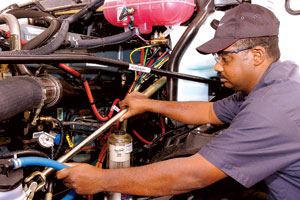Gauging an Engine’s Life Expectancy Starts with B-Life Rating

This story appears in the June 13 print edition of Equipment & Maintenance Update, a supplement to Transport Topics.
Engine makers are providing customers a gauge to help them determine how dependable and durable an engine is supposed to be, called a B-life rating. It’s regarded as the industry standard for measuring the life expectancy of an engine, but the figures are sometimes misunderstood.
The most frequently heard ratings are B10 and B50. B10 is the expected engine life in miles of operation, many times 1 million, before 10% of all of a specific model of engines in operation will require a major repair, overhaul or replacement, according to Navistar. B50 is 50%.
“The B-rating system is useful in giving customers a good idea of engine life expectations for a specific engine family,” said John Moore, Volvo Trucks powertrain product marketing manager. “For instance, the Volvo D11 engine does carry a B50 rating of 1.2 million miles, which is the same as the Volvo D13.”
BEST OF JUNE E&MU: More stories, columns
In other words, 50% of D11 and D13 models are expected to go 1.2 million miles before an overhaul or similar major repair.
“It’s important to remember that it is not an exact rating,” said Stu Russoli, highway and powertrain products marketing manager for Mack Trucks, “but rather a rule of thumb similar to a consumer guide number that might help a customer in their decision-making process.”
According to Mario Sanchez-Lara, on-highway marketing communications for Cummins, it’s not uncommon for a diesel engine to provide trouble-free service for double, even triple the B50 life. “Proper maintenance and care will ensure that you get the most from your engine. Following the OEM maintenance recommendations will help ensure that your engine meets or exceeds the manufacturer’s life expectancy.”
He said many people wrongly assume that B10 life means that at the given mileage, the engine will have worn 10%, and at B50 life, the engine will have worn 50%. “This is not the case, as B10 and B50 life uses a statistical approach to approximating engine life.”
Steve Gilligan, vice president of product marketing at Navistar, explained that B ratings are based on the durability data that engine manufacturers have on file and operating data. “They use that as a basis to establish warranty coverage and also to inform our customers who will ask us how long an engine is going to last. It’s a voluntary rating; this is where you are going to have a more sophisticated customer who is going ask those types of questions.”
Engine makers take different approaches in their use of these ratings. Cummins’ Sanchez-Lara says in order to have good statistical data to support those statements, engine makers must run a lot of tests and ensure they involve all of the different duty cycles the engines are going to see in the real world.
Cummins is “very careful [in how we] use those statements, because there could be one very severe application, with very inadequate maintenance that’s not really going to help the engine achieve that milestone,” he said. “And that’s not because the engine was not capable, but because that specific operation or application is an odd-ball and is not representative of some of the testing that was done to come out with a B-10 life of 1 million.”
He said Cummins has these statistical studies for its engines based on development, but the company is careful in how it uses them. “We prefer to go by the record of the engines in the industry that we have in years of real use.”
Part of the reason customers want to know the B life ratings has to do with the value of their trucks when it’s time to sell, according to Navistar’s Gilligan. “If a fleet owns a vehicle for let’s say five years … when they sell that vehicle they want to know it’s going to have a good residual value. The second owner is probably going to operate that vehicle for a similar period of time. So if the first owner … [put] half a million miles on it, the second owner wants to know that … if they are going to own it five years, they are also going to get half a million miles of life and that the engine isn’t simply going to wear out at 800,000 miles.”

